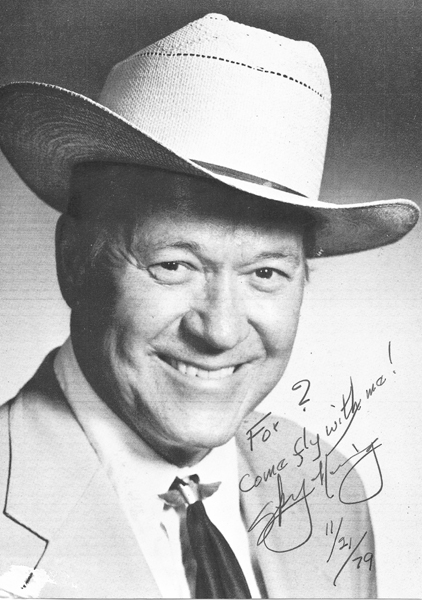
A note popped up on my laptop one evening recently. It was from our younger daughter. She’d been going through some things in the latest phase of moving into her new house and she’d stumbled across an old black-and-white photograph. It was a portrait of a middle-aged man with a smile and a Stetson. Scrawled over the photo was an incomplete inscription:
“For ?” In other words, the photo was for some unnamed person. Then there was a sign off. “Come fly with me! Sky King. 11/21/79.”
As well as sending the digital copy of the photo, our daughter wrote, “Any idea who this is?”
Because she had posted the photo and question on Facebook, a number of people in her digital circle of friends had begun to respond.
“Lead actor in TV show ‘Sky King,’” one said.
“Every Saturday,” another added.
I realized I’d better explain and told our daughter and everyone online this story.
Back in the late 1970s, when my wife and I moved our older daughter from Saskatchewan to Alberta in pursuit of greener freelance pastures, I suddenly became extremely busy. At the time, Alberta made it very attractive to invest in arts ventures – music recordings, documentaries, feature films, books and even entertainment TV series. And because many professionals – doctors, lawyers, engineers, architects – had lots of discretionary income, Alberta enticed them to invest in those arts projects.
If they succeeded, the profits would be gravy. If they failed, at the very least, the professionals could claim the investment as a tax-deductible loss. I became the beneficiary of one such project when I was hired to write a TV series called “Whatever Happened To…?”
In our pilot program (trial episode) I managed to track down and interview such former celebrities as Roger Bannister, the first man to run the sub-four-minute mile, Steve Prentice, a survivor of the Titanic sinking, and Kirby Grant, a 1950s journeyman actor who starred in that Saturday-morning TV Series “Sky King,” about a semi-retired enforcement officer who – in his spare time – chased down bad guys in the U.S. southwest using his twin-engine Cessna airplane.
Sky King was to me as popular as any of the Marvel superheroes of today. And in 1979, I managed to find him working as a public relations spokesman for Sea World in Florida. It turned out, however, that the only time he could see us that fall was exactly the week our second daughter (the one possessing the old photo) was due to be born. In fact, I was flying to Florida when she was born, a fact I’ve never been able to live down.
Back to the photograph. Partly to compensate for my absence at our second daughter’s birth, I thought I’d ask Kirby Grant – as we interviewed him for our show – to autograph a glossy photo of himself to our newborn daughter. However, at the time he signed the photo, my wife and I hadn’t named her; hence the “For ?” inscription on the picture.
Fortunately, my visit with Kirby Grant in 1979 precipitated another visit; several years later, we actually took both our daughters as children to Florida – partly for Disney World and partly to meet Dad’s childhood hero, Sky King, at Sea World. Well, it was a visit made in heaven.
Kirby was so gracious. He picked up our girls, told us – the parents – to go off and spend the day by ourselves, while he toured the girls to see sharks, dolphins and killer whales at Sea World. Kirby became proxy Grampa for a day. We stayed in touch for a few years afterward, but when Kirby really retired we lost touch.
Then, in 1985, I got a short, distressing card from Kirby’s wife. She told us that year that U.S. astronauts in the NASA Shuttle program had contacted her husband. The same way I had grown up with Sky King, so too had the Shuttle crew, who wondered if he would honour them by witnessing their blast off from Cape Canaveral that year. Kirby agreed and drove through the night from his home in Orlando to see them launch.
“Kirby must have fallen asleep at the wheel,” Kirby’s wife wrote us, “because he went off the road and was killed in the crash.”
I imagine the astronauts who’d invited Kirby were as crushed as I was, not to mention guilt-ridden. I guess because our girls were still very young, I never had the heart to tell them that their lovable, Stetson-wearing (yes, he still wore the hat and cowboy boots that had been his calling cards on TV in the 1950s) proxy Grampa had died.
And without knowing the final chapter to Kirby’s story, I guess that’s why our daughter, “?”, couldn’t figure out the significance of the half-signed photo. Suddenly, this week, it all fell into place, no doubt somewhat painfully.
Note to self: To avoid future confusion, always write captions on old photographs.
https://www.smithsonianmag.com/history/how-british-engineer-made-bomb-that-could-bounce-on-water-180969095/
https://en.wikipedia.org/wiki/Bouncing_bomb
Ted: Great talk earlier today in the Shwa about Squadron #617! Check out the importance of the Magnus Effect referred to on first website.
IJ